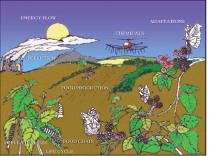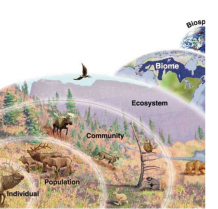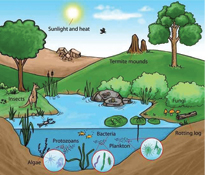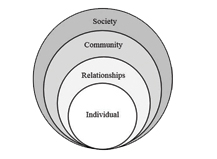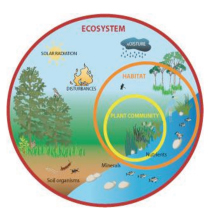Grade: 7-11Subject:
Biology, Life Science, Inter-Coordinated Science
Number of Lessons: 7
Students will learn about the life of Philip Vera Cruz and, through the creation of an Ecological Model of his life as a farmworker, will come to understand the relationships between organisms and their environment. Students will explore the different levels of interaction between organisms of the same species and across different species, culminating with their biome.
Students will:
- Learn to cite specific textual evidence to support analysis of science and technical texts, attending to the precise details of explanations or descriptions.
- Learn to determine the central ideas or conclusions of a text; trace the text’s explanation or depiction of a complex process, phenomenon, or concept; provide an accurate summary of the text.
- Learn to follow precisely a complex multistep procedure when carrying out experiments, taking measurements, or performing technical tasks, attending to special cases or exceptions defined in the text.
- Students will understand that the different levels of the Ecological Model are designed to demonstrate relationships among organisms and between organisms and their environment.
- Students will learn about the life of Philip Vera Cruz and his role in shaping both the Farm Worker’s Movement and the greater society.
- “Lesson 1 - Grape Concept Map” Handout
- “Lesson 2 - Ecological Model Notes” Handout
- “Lesson 2 - Ecological Model” Slides
- “Ecological Model Review” Handout
- “The Ecological Model of a Grape” Handout
- “The Ecology of a Grape” Reading
- “Lesson 5 - Drawing a Social-Ecological Model“ Handout
- “Lesson 6 - Read and Analyze Philip Vera Cruz" Handout
- “Lesson 7 - Philip Vera Cruz Social-Ecological Model Poster Assignment" Handout
- “Lesson 7 - Philip Vera Cruz Social-Ecological Model Rubric” Handout
- “United Farm Workers (UFW) Movement – Philip Vera Cruz, Unsung Hero” – Untold Civil Rights Stories
- “Unit Plan Biology Ecological Model and Philip Vera Cruz”
Recommended Supplemental Texts:
- Biology textbook
- Life Science or Inter-coordinated Science textbook
Materials Not Included:
- 1 bag of grapes (or one grape per student)
- LCD Projector & Screen/White Board
- Markers and Colored Pencils
- Poster Paper (at 3' x 3')
- Timer
- Abiotic Factors
- Biome
- Biosphere
- Biotic Factors
- Community
- Ecological Model
- Ecology
- Ecosystem
- Habitat
- Organism
- Population
- Social-Ecological Model
LESSON 1:
Is a Grape Just a Grape? (45 minutes)
Summary:
Introduce the concept of how an organism interacts with its environment by analyzing a common grape. Students can write or draw impressions they get when they think of, see, or hold a grape to spark student interest and help students establish connections with their own experiences.
Materials:
- “Lesson 1 - Grape Concept Map” Handout
Materials Not Included:
- 1 bag of grapes (or 1 grape per student)
Activity 2: Independent (10 minutes)
- Instruct students to independently draw the grape in the inner circle. Students are also allowed to draw a group of grapes, since they grow in bunches and might be more familiar with that image. In the next circle, students are to write 3 things they associate with grapes AND draw 3 things they associate with grapes. The written statements can be as short as one word and as long as a couple of sentences.
Then introduce these questions to students:
- How much work does it take to produce grapes or grape products?
- How are they made?
- Who do you think produces them?
- Why do we enjoy grapes so much? What makes them taste good?
- Have students then write 2 more things they associate with grapes and draw 2 more things they associate with grapes.
Activity 3: Classroom Discussions (15 minutes)
Have students share out their experiences with grapes. As they share, write their responses on the board. Invite students to get out of their seat and write a statement or draw a picture. Pay attention to ideas of “processes”, “labor”, “energy”, “interactions or relationships”, and questions they may pose.
Some possible discussion questions:
- How much work does it take to produce grapes or grape products?
- How are they made?
- Why do we enjoy grapes so much? What makes them taste good?
Activity 4: (5 minutes)
Have students add to their Concept Maps, two new things that someone else shared in their experiences with grapes.
Activity 5: Reflection (10 minutes)
Some possible discussion questions:
-
Have students respond to this prompt. They may use the back of the paper.
- “How is a grape not ‘just a grape’?”
- “How is it related or connected to other things?”
- Use at least 2 pieces of evidence from your concept map and class discussion.
- Then briefly explain the importance of how a simple object such as a grape involves so many interactions.
LESSON 2: The Ecological Model (Suggested Time: 45 minutes)
Students will explore the scientific concepts of an ecosystem, starting at the organism level and ending with the biosphere. Lesson is in lecture format and will employ the skill of note-taking.
Materials:
- “Lesson 2 - Ecological Model Notes” Handout
- “Lesson 2 - Ecological Model” Slides
Materials Not Included:
- LCD Projector
- Screen/White Board
Activity 1: (5 minutes)
Activity 2: Lecture (30 minutes)
First begin by telling students that this is good practice for Note-taking, a skill necessary in college and wherever a lecture is given. On the left column instruct students to write down the key terms, which in this case represents an important idea that they need to remember, just like regular Cornell Notes. This task is made easier by the PowerPoint presentation, which has underlined each key term. In the middle column students are expected to write any information related to this concept, such as definition and examples. This is also facilitated by the PowerPoint, which provides the definition for each term and a picture. Finally on the third column, students are expected to draw a picture related to the key term, to the best of their ability. This is to facilitate memory.
Activity 3: Reflection (10 minutes)
Have students respond in writing to this prompt:
“To what group, organization, association (such as family, neighborhood, church, etc.) do you belong to? How are these groups related? Give 2 examples.”
LESSON 3:
The Ecological Model Review (Suggested Time: 55-65 minutes)
Students will review the Ecological Model by answering questions. Students will practice written response strategies as they review the concepts in the previous lesson. Students base their responses using evidence from text or diagrams.
Materials:
- “Lesson 2 - Ecological Model Notes” Handout (filled out)
- “Lesson 3 - Ecological Model Review” Handout
Prior Knowledge:
Students need to have their Ecological Model Notes.
Materials Not Included:
- Timer
Activity 1: (5 minutes)
Activity 2: Instructions (5 minutes)
Instruct students that they may only use their notes as reference, and not the book. This is because it is an exercise to self-evaluate how well we take notes. If they are missing a piece of information, they can share their notes with their partner. Only after conferring with their partner, are they allowed to find the information from other people. This would be a good time to introduce the RACE Method. Have students copy this down on their paper, or have this featured on the board:
- R=Restate the question
- A=Answer it
- C=Cite evidence (Use "For example,..." as a sentence starter)
- E=Explain evidence (Use "This means that,..." as a sentence starter)
Activity 3: (5 minutes)
Answer the first question with the students, calling upon students to provide examples or ideas about how to word the answer.
Activity 4: (5 minutes)
Have students answer the next question in pairs. Time this activity.
Activity 5: (5 minutes)
At the end of the time, ask student volunteers to provide examples of answers (partial answers are ok). Primarily check for the appropriate use of the RACE method. Provide sentence starters for Basic/Below Basic.
Activity 6: (30-40 minutes)
Differentiated Instruction:
- Advanced/Proficient Level: Treat this activity like a lab. Provide minimal scaffolding, by allowing students to troubleshoot. Defer questions back to their partner. (“What do you think?”). Allow them to self-evaluate (“Did you use all of the components of the RACE method?”).
- Basic: Emphasize the sentence starters. Remind students to look in their notes. Provide each question with a limited amount of time and ask for feedback from the class. Call on students randomly. Allow students to confer with partner before answering publicly.
- Below Basic: Since this is a group activity, walk along the groups and spend more time with students who are struggling. Pay attention to vocabulary or concepts that they have difficulty grasping. Remind them to refer back to their notes and provide encouragement.
LESSON 4:
The Ecology of a Grape (Suggested Time: 80-90 minutes)
Students apply the concepts of an Ecological Model to a common household item, the grape. Students practice reading skills and drawing evidence from text. Students learn about all the people, resources, and environmental factors that go into growing grapes.
Materials:
- “Lesson 2 - Ecological Model Notes”
- “Lesson 3 - Ecological Model Review” (Optional)
- “Lesson 4 - The Ecological Model of a Grape” Handout
- “Lesson 4 - The Ecology of a Grape” Handout
Activity 1: (5 minutes)
- Ask some student volunteers to distribute “The Ecology of a Grape” Handout and “Lesson 4 - The Ecological Model of a Grape” Handout.
- Ask the rest of the class to take out their Ecological Model Notes and the Ecological Model Review.
- Divide students into mixed-ability pairs.
Activity 2: Introduce Reading & Instructions (5 minutes)
- Introduce the reading by referring back to the experiences that the class discussed when they completed their Lesson 1 - Grape Concept Map. Explain that they are going to read information about grapes, where they come from and where they grow.
- Please ask students to: (It’s a good idea to write these on the board or project them)
- Number the paragraphs on the left margin.
- On the right margin, ask students to draw the symbols or pictures from their Ecological Model Notes. At least 1 per paragraph, wherever that concept is discussed.
Activity 3: Model (5 minutes)
Model using the first paragraph. Ask students to provide possible connections. Remember: there is no one right answer, but some answers are better than others.
Activity 4: Introduce Reading & Instructions (5 minutes)
Have students work in pairs.
Provide students with a time limit and discuss as whole class their answers.
Activity 5: Reading (5 minutes)
Differentiated Instruction:
- If you feel students require more support, you can go paragraph by paragraph providing students with a time limit and a discussion after every paragraph or you can give students a block time and discuss at the end of the whole reading.
Activity 6: Reading (30-40 minutes)
Differentiated Instruction:
- Advanced/Proficient Level: Treat this activity like a lab. Provide minimal scaffolding, by allowing students to troubleshoot. Defer questions back to their partner. (“What do you think?”). Allow them to self-evaluate (“Did you use all of the components of the RACE method?”).
- Basic: Emphasize the sentence starters. Remind students to look in their notes. Provide each question with a limited amount of time and ask for feedback from the class. Call on students randomly. Allow students to confer with partner before answering publicly.
- Below Basic: Since this is a group activity, walk along the groups and spend more time with students who are struggling. Pay attention to vocabulary or concepts that they have difficulty grasping. Remind them to refer back to their notes and provide encouragement.
LESSON 5: Drawing a Social-Ecological Model (Suggested Time: 50 minutes)
Students apply the concepts of an Ecological Model across disciplines identifying the conceptual commonalities in the Sciences and the Social Sciences. Students engage in self-reflection by applying the Social-Ecological Model to their own lives.
Materials:
- “Lesson 2 - Ecological Model Notes” (optional).
It would be helpful to have Ecological Model Notes out for students to make connections
- “Lesson 5 - Drawing a Social-Ecological Model” Handout
Activity 1: (5 minutes)
Have the students read and annotate the following texts, noting connections between them and the
Untold Civil Rights Stories articles. How are these texts “in conversation” with one another?
Activity 2: Instruction (5 minutes)
- Begin on the side of the handout that is titled “Lesson 5 - Drawing a Social-Ecological Model”. You may begin with the discussion questions:
- Why is it important to know where something is from?
- Why is it important to know where an animal is from?
- Why is it important to know where a person is from?
- What’s similar about the answers for all three questions?
- Pay attention and emphasize concepts such as: factors that shape and influence relationships between the individual and the environment/whole. Read the directions out loud to them and make sure they understand that Figure 1 is located on the other side of the handout.
Activity 3: Model (5 minutes)
Model using the first circle (smallest). Ask students to provide possible connections.
Remember: there is no one right answer, but some answers are better than others.
Activity 4: Practice (5 minutes)
Have students work in pairs to work on the next circle. “Family,” “Household,” or “Neighborhood” are good categories for the next (bigger) circle. Provide students with a time limit and discuss as whole class their answers.
Differentiated Instruction:
- Ask students to remember the question: “Is this a part of that or the other way around?”
Activity 5: Completion (30 minutes)
Have students complete their own Social Ecological Model and answer the three questions.
Differentiated Instruction:
- Advanced/Proficient Level: Treat this activity like a lab. Provide minimal scaffolding, by allowing students to troubleshoot. Defer questions back to their partner. (“What do you think?”). Allow them to self-evaluate (“Did you use all of the components of the RACE method?”). Make connections between Ecology and Society (“A family or neighborhood is like a Population”).
- Basic: Emphasize the sentence starters and question “which is a part of which?” Remind students to look in their notes. Provide each question with a limited amount of time and ask for feedback from the class. Call on students randomly. Allow students to confer with partner before answering publicly.
- Below Basic: Since this is a group activity, walk along the groups and spend more time with students who are struggling. Pay attention to vocabulary or concepts that they have difficulty grasping. Make analogies using their own experience. Remind them to refer back to their notes and provide encouragement. Validate guesses.
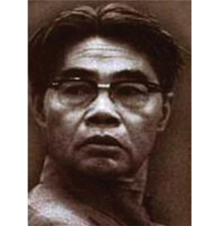
LESSON 6:
Philip Vera Cruz (Suggested time: 60 minutes)
Students will apply their knowledge of the Ecological Model using the life of Philip Vera Cruz. Students will practice a reading strategy (“Read and Review”) to draw meaning from text. Students will then use the Ecological Model to explain how Philip Vera Cruz was influenced by his environment but also shaped it.
Materials:
- “Lesson 2 - Ecological Model Notes”
- “The Ecology of a Grape” Reading
- “Lesson 5 - Drawing a Social-Ecological Model” Handout
- “Lesson 6 - Read and Analyze – Philip Vera Cruz” Handout
- “United Farm Workers (UFW) Movement: Philip Vera Cruz, Unsung Hero” Reading
Activity 1: (5 minutes)
Activity 2: Reflection & Class Discussion (15 minutes)
Introduce the reading by asking students to write half a page on the following: “How can an individual impact his/hers/its environment?"
Give at least 2 examples and at what level of the Social-Ecological Model or the Ecological Model.
Allow 7 minutes for writing and 8 minutes for class discussion.
Activity 3: Read & Analyze Instructions (5 minutes)
Activity 4: Model (5 minutes)
Model using the first paragraph. Ask students to provide possible connections.
Remember: there is no one right answer, but some answers are better than others.
Activity 5: Practice (5 minutes)
Have students work in pairs. Provide students with a time limit and discuss as whole class their answers.
Activity 6: Read & Analyze (30-40 minutes)
- Have students work in pairs. Provide students with a time limit and discuss as whole class their answers.
- Have students continue reading the “United Farm Workers (UFW) Movement: Philip Vera Cruz, Unsung Hero” Reading and fill out “Read and Analyze – Philip Vera Cruz” Handout.
Differentiated Instruction:
- Advanced/Proficient Level:Treat this activity like a lab. Provide minimal scaffolding, by allowing students to troubleshoot. Defer questions back to their partner. (“What do you think?”). Allow them to self-evaluate (“Did you use all of the components of the RACE method?”).
- Basic: Have students identify which Ecological Model Categories this paragraph is not talking about. Remind students to look in their notes. Provide each question with a limited amount of time and ask for feedback from the class. Call on students randomly. Allow students to confer with partner before answering publicly.
- Below Basic: Since this is a group activity, walk along the groups and spend more time with students who are struggling. Pay attention to vocabulary or concepts that they have difficulty grasping. Remind them to refer back to their notes and provide encouragement. Validate guesses.
Activity 7: Reflection (10 minutes)
Ask students to respond in writing to the following prompt:
“How was Philip Vera Cruz shaped or influenced by his environment? How did Philip Vera Cruz affect or influence his environment?” Provide at least one example of each and explain at what level of the Ecological or Social-Ecological Model each example fits.”
LESSON 7:
Social Ecological Model of Philip Vera Cruz (Suggested Time: 70-80 minutes)
After learning about the Ecological Model from a Science perspective and using the concept across disciplines, students are ready to utilize this concept to express their analysis of how organisms affect and are affected by their environment.
Materials:
- “Lesson 2 - Ecological Model Notes” (optional)
- “Lesson 5 - Drawing a Social-Ecological Model” Handout
- “Lesson 6 - Read and Analyze Philip Vera Cruz” Handout
- “Lesson 7 - Philip Vera Cruz Social-Ecological Model Poster Assignment” Handout
- “Lesson 7 - Philip Vera Cruz Social-Ecological Model Rubric” Handout.
Each sheet has two rubrics. Pass out one rubric to each student for grading.
- “United Farm Workers (UFW) Movement - Philip Vera Cruz, Unsung Hero” Reading
Materials Not Included:
- Markers and Colored Pencils
- Poster Paper (at lease 3' x' 3')
Activity 1: (5 minutes)
Activity 2: Group Roles (10 minutes)
Inform the students that they will be working on a group poster assignment. However, before they can get started, they must first determine their role in the completion of this assignment.
Roles:
Facilitator: Is in charge of making sure team understands what they are supposed to do. Communicates with teacher regarding clarification. Encourages team to perform their best.
Materials Manager: Ensures that the team spends their resources wisely. This includes time management, staying on task. Makes sure team has what they need to complete the assignment.
Scientist: Makes sure that all the required components of the assignment are being fulfilled accurately. Refers back to notes or uses textbook to check facts and accuracy.
Designer: includes everyone’s ideas into a design that is aesthetically pleasing and contains all of the necessary components. Makes sure poster is colorful and balanced.
Teacher Notes: Have these roles projected throughout the duration of this assignment or you may ask students to copy this down. Students can self-select roles or you can do it, depending on class. If there are groups of three or five, have someone double upon the roles or share the responsibility.
Activity 3: Instructions for Poster Assignment (5 minutes)
Activity 4: Poster Assignment (30-35 minutes)
Differentiated Instruction:
- Advanced/Proficient Level: Treat this activity like a lab. Provide minimal scaffolding, by allowing students to troubleshoot. Defer questions back to their team. (“What do you think?”). Allow them to self-evaluate (“Have you fulfilled all of the required components?”).
- Basic: Emphasize participation. Validate guesses. Remind students to look in their notes. Provide each instruction with a limited amount of time and ask for feedback from the class. Call on students randomly.
- Below Basic: Since this is a group activity, walk along the groups and spend more time with students who are struggling. Pay attention to vocabulary or concepts that they have difficulty grasping. Remind them to refer back to their notes and provide encouragement.
Activity 5: Grading (20 minutes)
- You can grade on your own or you can invite students to grade with you.
- Redistribute the posters to another group or have another class grade their work.
- Pass out one “Philip Vera Cruz Social-Ecological Model Rubric” to each student. Ask students to grade each component of the poster.
- Walk around to verify if students are grading fairly. You’ll be pleasantly surprised.
“History.” Tablegrape.com. California Table Grape Commission. n. d. Web. 13 Jan. 2016.
Reeves, Margaret, Anne Katten, and Martha Guzman. "Fields of Poison 2002: California
Farmworkers and Pesticides." Californians for Pesticide Reform 1 (2002). Print.
“The Social-Ecological Model: A Framework for Violence Prevention.” Centers for Disease
Control and Prevention. CDC, 25 Mar. 2015. Web. 13 Jan. 2016.
"Viniculture.”Professional Friends of Wine. Jim LaMar, 8 Jan. 2000. Web. 5 Jan. 2016.
California Common Core Standards Addressed
Next Generation Science Standards for California Public Schools
Disciplinary Core Ideas: LS2.A: Interdependent Relationships in Ecosystems:
Ecosystems have carrying capacities, which are limits to the numbers of organisms and populations they can support. These limits result from such factors as the availability of living and nonliving resources and from such challenges such as predation, competition, and disease. Organisms would have the capacity to produce populations of great size were it not for the fact that environments and resources are finite. This fundamental tension affects the abundance (number of individuals) of species in any given ecosystem. (HS-LS2-1), (HS-LS2-2)
Disciplinary Core Ideas: LS2.C: Ecosystem Dynamics, Functioning, and Resilience
A complex set of interactions within an ecosystem can keep its numbers and types of organisms relatively constant over long periods of time under stable conditions. If a modest biological or physical disturbance to an ecosystem occurs, it may return to its more or less original status (i.e., the ecosystem is resilient), as opposed to becoming a very different ecosystem. Extreme fluctuations in conditions or the size of any population, however, can challenge the functioning of ecosystems in terms of resources and habitat availability. (HS-LS2-2),(HS-LS2-6)
Moreover, anthropogenic changes (induced by human activity) in the environment—including habitat destruction, pollution, introduction of invasive species, overexploitation, and climate change—can disrupt an ecosystem and threaten the survival of some species. (HS-LS2-7)
Science and Engineering Practices:
Developing and Using Models: Modeling in 9–12 builds on K–8 experiences and progresses to using, synthesizing, and developing models to predict and show how relationships among variables between systems and their components in the natural and designed worlds.
Develop and use a model based on evidence to illustrate the relationships between systems or between components of a system. (HS-LS1-2)
Use a model based on evidence to illustrate the relationships between systems or between components of a system. (HS-LS1-4), (HS-LS1-5), (HS-LS1-7)
Crosscutting Concepts:Energy and Matter
Energy cannot be created or destroyed—it only moves between one place and another place, between objects and/or fields, or between systems. (HS-LS2-4)
Energy drives the cycling of matter within and between systems. (HS-LS2-3)
Crosscutting Concepts:Scale, Proportion, and Quantity
The significance of a phenomenon is dependent on the scale, proportion, and quantity at which it occurs. (HS-LS2-1)
Using the concept of orders of magnitude allows one to understand how a model at one scale relates to a model at another scale. (HS-LS2-2)
Systems and System Models
Models (e.g., physical, mathematical, computer models) can be used to simulate systems and interactions—including energy, matter, and information flows—within and between systems at different scales. (HS-LS2-5)
CSL.9-10.4
Present information, findings, and supporting evidence clearly, concisely, and logically (using appropriate eye contact, adequate volume, and clear pronunciation) such that listeners can follow the line of reasoning and the organization, development, substance, and style are appropriate to purpose (e.g., argument, narrative, informative, response to literature presentations), audience, and task.

